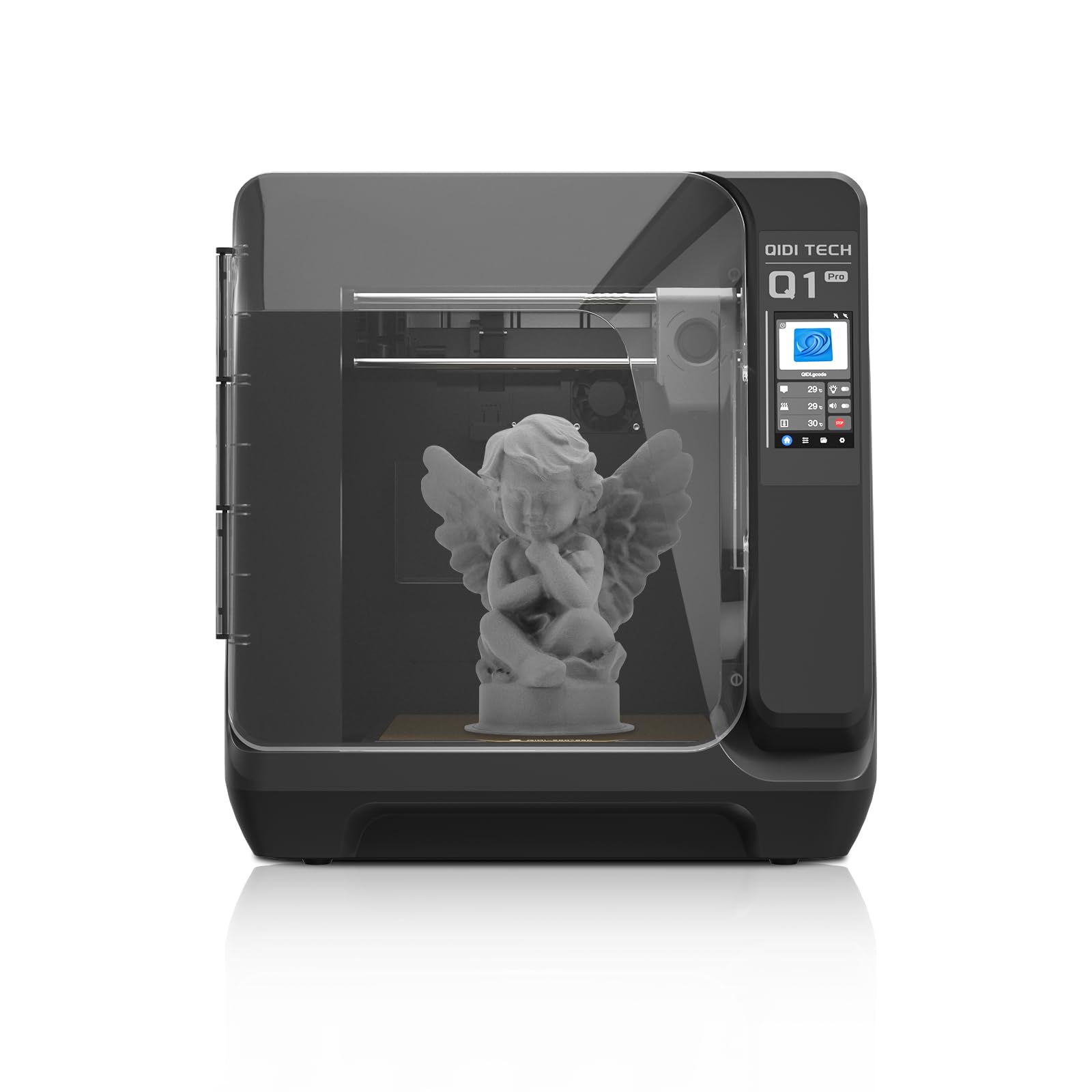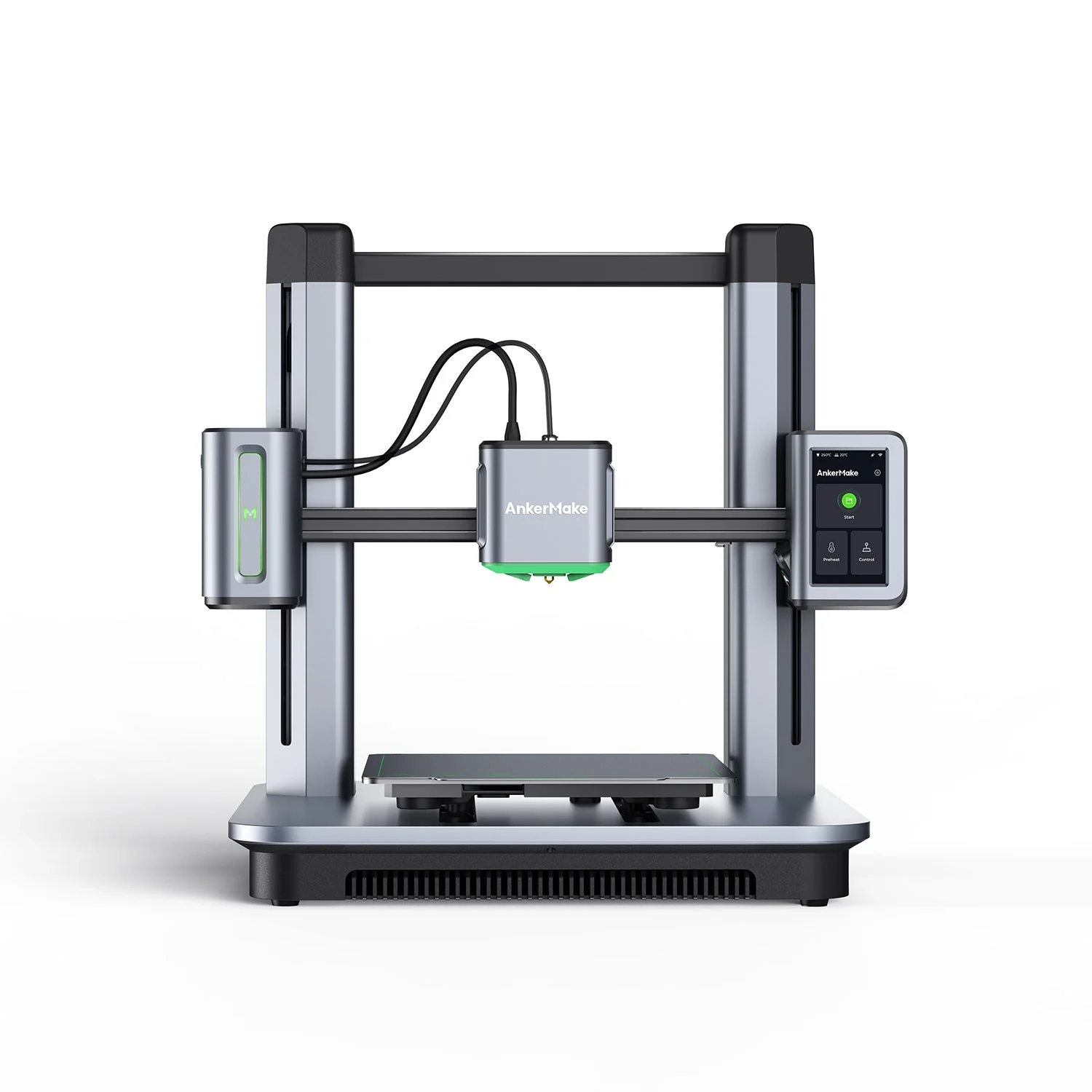Compare Q1 PRO vs M5
Comparison between the best 3D printers
Choose the best 3D printer at the best price. The cheapest 3D printers are here.
Buy a 3D printer here with 3D Fila.
 |
 |
|
| Model | Q1 PRO[BUY Q1 PRO] |
M5 |
| Printing Material | Filament | Filament |
| Buy Filament for QIDI Q1 PRO | Buy Filament forAnkerMake M5 | |
| Estimated price | $449,00 | $497,00 |
| Manufacturer | QIDI | AnkerMake |
| Release Year | 2024 | 2023 |
| Print Volume [mm] | 245x245x245 | 235x235x250 |
| Printer Size [mm] | 467x477x489 | 502x438x470 |
| Weight [kg] | 20 | 12,6 |
| Power Loss Recovery | YES | YES |
| Enclosed printer | YES | NO |
| Bed Leveling | Automatic | Automatic |
| Filament End Sensor | YES | YES |
| Bed type | Heated | Heated |
| Power supply system | Direct Drive | Direct Drive |
| Standard nozzle | 0,4 | 0,4 |
| Maximum Nozzle Temperature [°C] | 350 | 260 |
| Maximum Bed Temperature [°C] | 120 | 100 |
| Maximum printing speed [mm/s] | 600 | 500 |
| Filament holder | YES | YES |
| Camera for supervision | YES | YES |
| Recommended filaments | PLA、ABS、ASA、PETG、TPU、PC、PA、PA-CF、PET-CF、PAHT-CF etc. | PLA, PETG, ABS |
| Recommended slicers | QIDI Slicer/Cura/Simplify 3D/ORCA/PRUSA Slicer | AnkerMake Studio (macOS, Windows), Simplify3D, Ultimaker Cura, PrusaSlicer |
| Maximum Resolution [mm] | 0,1 | 0,1 |
| Processor | Cortex-A53,64-bit Processor | |
| Display | Touchscreen 4,3'' | Touchscreen 4,3'' |
| Power Supply | 350 W | 350 W |
| Connectivity | WiFi/USB Flash Drive/Ethernet Cable | Wi-Fi, USB-C, OTA Upgrade |
| Operating systems | Windows, Linux, Macbook | Windows, Linux, Macbook |
| Date of registration in the system | 2024-07-09 | 2024-07-08 |
| Release date | 2024 | 2023 |
| Extra features | The QIDI Q1 Pro 3D printer stands out for its Core XY structure and heating chambers that reach up to 60ºC, ideal for advanced materials such as ABS and Nylon. It features Klipper firmware, an automatic leveling system, a high-flow extruder with a double metal nozzle and a hotend that reaches 350ºC. It offers connectivity via Wi-Fi, USB and Ethernet, as well as a 1080p camera for remote monitoring and an intuitive touchscreen for easy operation. | The AnkerMake M5 printer stands out for its impressive print speed, reaching up to 500mm/s. It features AI print monitoring, an integrated camera for creating timelapses, auto-leveling bed with pressure sensor, direct extruder, flexible PEI-coated build plate, and Wi-Fi and USB-C connectivity. Assembly is quick and easy, and the printer is designed to deliver high print quality and ease of use. |
| Support for multiple colors and materials (AMS and CFS) | NO | NO |
Notes * |
||
| Cost-benefit | 8 / 10 | 7 / 10 |
| Hardware | 4.8 / 10 | 3.5 / 10 |
| Tela | . | . |
| Print volume | 3 / 10 | 3 / 10 |
| Performance | 5 / 10 | 4 / 10 |
| [BUY Q1 PRO] |
Conclusion |
| In comparing the QIDI Q1 Pro and the AnkerMake M5 3D printers, several key factors come into play, including functionality, build quality, price, and performance attributes that cater to different user needs. The QIDI Q1 Pro, although potentially riding at a more accessible price point, showcases superior capabilities, particularly with its higher maximum nozzle temperature and heated chamber. These features make it more suitable for printing with advanced materials like ABS and Nylon, which require consistent temperature control. Its design includes extra features such as a high-flow extruder, a robust touch screen interface, and comprehensive connectivity options. The Core XY structure enhances its stability and precision in printing, contributing to high-quality outputs. On the other hand, the AnkerMake M5, while slightly more expensive, excels in speed, offering faster print rates and a user-friendly setup. Its AI print monitoring and integrated camera for timelapse creation appeal to users who prioritize rapid production and engaging visual outputs. The M5’s lightweight build aids in portability, and its easy assembly is a notable advantage for beginners. Both printers possess automatic bed leveling and support for standard filaments like PLA, ABS, and PETG, maintaining a level of similarity in basic functionality. However, the QIDI Q1 Pro edges ahead concerning build quality and versatility, particularly for advanced material use. Conversely, AnkerMake M5's strengths lie in its speed and ease of use, making it ideal for users focused on efficiency and less complex materials. In conclusion, the best choice between these two models ultimately depends on the user’s specific needs. Those seeking robust performance with various materials might find the QIDI Q1 Pro more suitable, while users looking for a quick, efficient, and easy-to-use printer may lean towards the AnkerMake M5. Both printers provide strong cost-to-benefit ratios, yet cater to slightly different markets within the 3D printing community. |

